Award-Winning Plants of 2024
April 9th, 2024
Organizations of growers, horticulturists, researchers, and other plant experts each year bestow assorted awards on what they believe to be the best of the best plants.
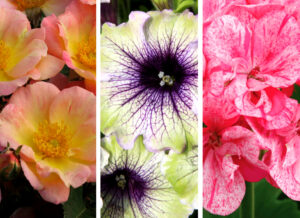
Some of the plants that have won 2024 awards.
Some of these award-winners are new introductions. Others are under-known or under-appreciated oldies-but-goodies that deserve more use in home gardens.
Here’s a look at plants that have won honors for 2024:
A panel of experts assembled by the Pennsylvania Horticultural Society (best known for running the Philadelphia Flower Show) each year picks a half-dozen trees, shrubs, and perennials worthy of greater use in Pennsylvania landscapes.
For 2024, two shrubs, two perennials, a small flowering shrub, and the first entry in a new category (edibles) made the Gold Medal grade.
Buttonbush Sugar Shack
This is a compact and heavier-blooming version of a Pennsylvania native shrub (Cephalanthus occidentalis). Sugar Shack produces fragrant, round, white flowers in summer on plants that grow about five feet tall and wide. Fall-foliage color is copper-red along with round red fruits. It grows best in moist sunny to partly shaded spots.
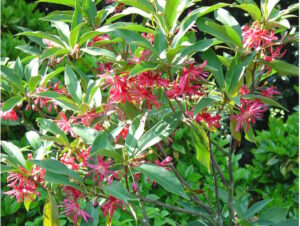
Florida anise ‘Woodland Ruby’
Credit: Pa. Horticultural Society
Florida anise ‘Woodland Ruby’
This variety of a little-known southern U.S. native shrub (Illicium) is cold-hardy to most of Pennsylvania and attractive for its long-lasting, summertime, mildly fragrant red flowers. ‘Woodland Ruby’ grows six to seven feet tall, is resistant to deer browsing, and does best in sun or part shade.
Japanese roof iris
A little known form of Japanese-native iris (Iris tectorum), this perennial produces upright strappy foliage about 12 to 18 inches tall and bluish-purple flowers in late spring. Plants colonize to make a tight, deer-resistant groundcover. Grows in full sun to part shade.
Foamflower ‘Brandywine’
This variety of our native foamflower (Tiarella cordifolia) is an ideal early-spring pollinator perennial with its short, white plumes in April and May. It does best in damp, shady sites but also tolerates the dry shade under big trees – and isn’t a likely target of deer.
Magnolia ‘Genie’
‘Genie’ is distinctive for its narrow habit – a tree that grows slowly to about 12 feet tall but only five feet wide in 20 years. It produces classic, large magnolia flowers that are purplish-red in color and that peak in late spring but appear sporadically throughout summer. This tree grows best in somewhat damp, acidic soil in full-sun to part-shade locations.
Asparagus ‘Millennium’
The Gold Medal program’s first edible award-winner is this variety of asparagus that is fast becoming the flag-bearer in home gardens. ‘Millennium’ is a high-yielding asparagus with good flavor and green ferny foliage that turns yellow in fall. Plants grow three to four feet tall and perform best in full sun.

Phlox ‘Jeana’ is the 2024 Perennial Plant of the Year.
Members of the Perennial Plant Association vote to honor one perennial plant each year that’s superior in terms of performance, low care, pest resistance, and multiple-season interest. The 2024 winner is…
Phlox ‘Jeana’
‘Jeana’ is a U.S.-native tall garden phlox that’s been a top-seller for years for its plentiful flowers, sturdy habit, pollinator-friendliness, and especially its resistance to the powdery-mildew disease that plagues so many phlox varieties.
Flowers are fragrant and lavender-pink in color, peaking in mid-summer. Including the flower spikes, plants grow four to five feet tall. Best in full sun.
Garden Club of America Plant of the Year
This award is bestowed by the national organization of garden clubs, which appoints a plant-expert panel to name one outstanding U.S.-native plant worthy of the Montine McDaniel Freeman Medal.
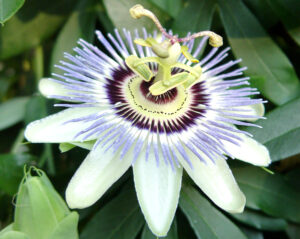
Maypop is 2024’s Garden Club of America Plant of the Year.
The 2024 medal-winner:
Maypop
Also known as passionflower or passionvine (Passiflora incarnata), maypop is a southeastern U.S. native that’s the hardiest in this genus of trailing/vining woody perennials (USDA Zones 6-10).
The vines produce crown-like lavender flowers that attract a variety of pollinators. It dies to the ground in Pennsylvania winters. Grows in full sun to part shade.
Independent researchers each year evaluate hundreds of new flowers and vegetables in dozens of trial gardens throughout the United States. The highest scorers get All-America Selections awards in a program that dates to 1932.
Two new vegetables and five new annual flowers were good enough to win 2024 national AAS honors.
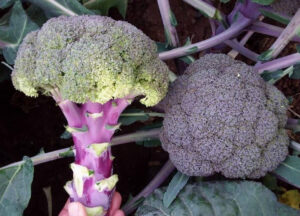
Broccoli Purple Magic
Credit: All-America Selections
Broccoli Purple Magic
Purple Magic is a good-looker with magenta-purple stems and purple heads.
Heat-tolerant plants grow about 30 inches tall and produce one large, main head about 90 days after transplanting into the garden. Best in full sun.
Pepper Red Impact
AAS judges liked Red Impact it for its large fruits, heavy yield, thick walls, disease-resistance, and excellent sweet flavor.
Plants produce 10 to 15 fruits each, averaging eight inches in length. Fruits mature from green to red about 75 days from transplant. Best in full sun.
Petchoa EnViva Pink
EnViva Pink is a cross between petunias and calibrachoa that AAS judges liked for its heavy bloom of large, bright-pink flowers with yellow throats.
Plants grow 12 to 14 inches tall, have good heat tolerance, and are ideal in sunny containers or hanging baskets.
Celosia Burning Embers
This celosia with the bronze, pink-veined leaves also stands out for its large and long-lasting, pollinator-friendly, pinkish-red flower plumes.
Burning Embers plants grow a stocky eight to nine inches tall, they’re heat- and humidity-tough, and the flowers don’t need to be dead-headed. Best in full sun.
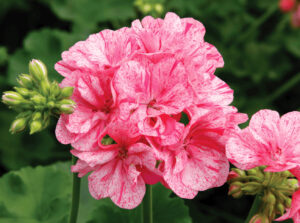
Geranium Pink Batik
Credit: All-America Selections
Geranium Big EEZE Pink Batik
The unusual mosaic flower color of this new hybrid geranium is what earned Pink Batik its 2024 All-America Selections award.
AAS judges called the two-tone pink flowers “absolutely beautiful and plentiful.” Plants grow about 18 inches tall and produce up to 100 blooms per season, especially when the spent clusters are dead-headed after they brown. Does well in full sun or part shade.
Impatiens Solarscape XL Pink Jewel
Pink Jewel is one of a new breed of disease-resistant impatiens that fight off the deadly downy mildew disease that decimates older impatiens.
This one, however, is seed-grown, meaning it can be produced less expensively than the cutting-grown varieties that typically cost $4 or more in one-plant pots.
Plants bloom a satiny-pink and grow into foot-tall mounds in most any light from full sun to full shade.
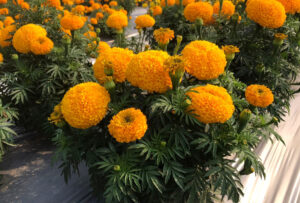
Marigold Siam Gold
Credit: All-America Selections
Marigold Siam Gold
This stocky new marigold with the big golden flowers is the year’s fifth AAS national annual-flower winner.
Among the traits that earned Siam Gold AAS honors: sturdy stems (no staking needed), flowers held above the foliage for good visibility, uniform growth, lots of blooms throughout the season, and excellent heat- and drought-resistance.
Plants grow about 20 inches tall, ideally in full sun, and are hardly ever bothered by deer, bunnies, or groundhogs.
Originally a program of the Mailorder Gardening Association, Green Thumb is now run by the National Garden Bureau, a century-old non-profit organization that promotes gardening on behalf of the horticulture industry.
NGB has two sets of award-winners: a People’s Choice category based on voting by the gardening public and a Professional Choice category based on voting by garden writers, breeders, retailers, brokers, and growers.
The 2024 People’s Choice Green Thumb award-winners:
Cucumber ‘Quick Snack’
Part of the Kitchen Minis line of compact plants bred for indoor growing, ‘Quick Snack’ is a self-pollinating variety that produces small, snack-sized fruits, even in fairly low light.
It also won best-edible in Professional Choice voting.
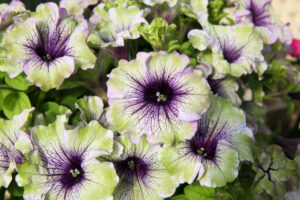
Petunia Amazons Plum Cockatoo
Credit: National Garden Bureau
Petunia Amazonas Plum Cockatoo
This novel, tri-color new petunia is one of two annuals to win People’s Choice awards for 2024. The flowers have dark purple throats and veins on white petals that are green and ruffled at the tips. Plants grow a mounding 12 to 14 inches tall in full sun to light shade.
Agapanthus Black Jack
Perennial in warmer climates, this lily-like plant with the glossy, strappy leaves is distinctive for its striking dark purple flowers atop sturdy stems.
Plants grow about 20 inches tall, ideally in full sun.
Better Boxwoods
This new line of blight-resistant boxwoods helps head off our latest deadly plague threatening boxwoods (boxwood blight).
Dubbed “The Blight Fighter” with a super-hero logo, Better Boxwoods are debuting with four varieties of different shapes and sizes.
The Skylight variety – a narrow upright growing to about eight feet tall and three to four feet across – won the 2024 Green Thumb Award as the year’s best new shrub.

Wax plant Coral Reef Red
Credit: National Garden Bureau
Wax plant Coral Reef Red
Both gardeners and pros awarded the Green Thumb houseplant award of 2024 to wax plant (Echeveria) Coral Reef Red.
This succulent, which is cold-hardy enough to survive most Harrisburg winters in the ground outside, is unusual for its dark-red and wavy/ruffled leaves. Plants grow 12 inches tall and produce creamy white, bell-shaped flowers.
The remaining 2024 Professional Choice Green Thumb award-winners are:
Begonia Stonehedge Rose Bronze Leaf
One of two annuals to win the pros’ nod, Stonehedge Rose Bronze Leaf is a huge begonia that grows into a four-foot by three-foot bush.
The glossy leaves are bronze, and the plentiful, season-long flowers are rose. Grows in full sun to part shade.
Centaurea The Bride
The vanilla-scented white, round, frilly flowers earned this newcomer its best-annual Green Thumb Award.
Plants grow a bushy, upright 28 to 36 inches tall and bloom all summer. Best in full sun.
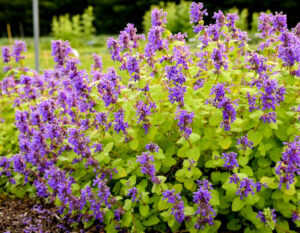
Catmint ‘Chartreuse on the Loose’
Credit: Walters Gardens Inc.
Catmint ‘Chartreuse on the Loose’
NGB’s professional panel liked this new catmint as best new perennial of 2024 for its novel chartreuse foliage.
‘Chartreuse on the Loose’ pairs the goldenish leaves with traditional blue catmint flowers, which bloom and then rebloom throughout most of the season. The foot-tall plants are heat-tough, drought-tough, and grow best in full sun.
Hydrangea Eclipse
This new bigleaf hydrangea is being touted as the “first true dark-leaf mophead hydrangea,” the attribute that earned it its top-shrub Green Thumb honor.
The dark-purple leaves hold their color even in warm weather and pair nicely with the ball-shaped, dark-purple to cranberry-colored blooms. Plants grow three to five feet tall and wide, ideally in morning sun and dappled afternoon shade.
Herb Society Notable Native Herb
Every year, the Herb Society of America’s Native Herb Conservation Committee selects one or more native plants that deserve recognition. The selections are called Notable Native Herbs (although not all are what’s generally considered to be herbs).
For 2024, a pair of tropicals won Notable Native honors:
Indian fig cactus
A relative to our cold-hardy perennial prickly pear cactus, this cactus (Opuntia ficus-indica) looks threatening with its spiny pads but produces rosy-pink flowers that are attractive to a variety of pollinators.
People also use the liquid in the pads in a variety of ways, including drinks, syrups, jams, candies, and even as a poultice for wounds. It’s winter-hardy only in Zones 9-12, though – well out of central Pennsylvania’s range.
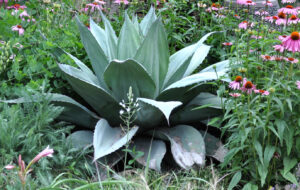
Century plant (Agave)
Century plant
Native to the desert southwest U.S., century plants (Agave americana) are cold-hardy only where winters stay above 20 degrees. Otherwise, plants need to be potted and moved indoors.
Plants produce spiny, upright, blue, sword-like leaves three to five feet long and spread up to 10 feet wide in time. They bloom only every 10 to 30 years, but then they’re a favorite of bats and nighttime hawk moths.
People use the sap for tequila and other beverages and the roots for sugar, syrup, and fibers.
American Garden Rose Selections
This program of the rose industry and American Rose Society evaluates roses at 14 different trial gardens in six U.S. geographical regions, looking for superior performance in beauty, fragrance, ease of care, and especially disease resistance.
No roses won in our Northeast region this year, but one of the three other AGRS regional winners won a national Fragrance Award:
Sweet Mademoiselle
This hybrid-tea rose from Chester County’s Star Roses and Plants has strongly sweet-scented peachy-pink to apricot flowers on five-foot-tall plants.
American Rose Trials for Sustainability
A.R.T.S. is an independent, non-profit rose-evaluation program that aims to identify the regionally best roses in eight different U.S. climate regions.
No-spray evaluations at 19 botanic-garden, university, and park trial sites look at bug and disease resistance, drought tolerance, beauty, vigor, and more over two years. Ones that out-perform the comparison industry standards win “Local Artist” awards, and ones that win awards in four or more regions are designated Master Roses.
Seven roses scored well enough to earn 2024 Local Artist honors in our region.
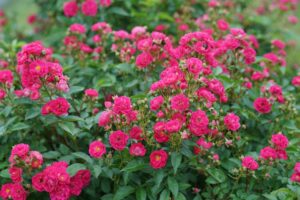
Rose Oso Easy Peasy
Credit: American Rose Trials for Sustainability
Oso Easy Peasy
A polyantha-type rose that grows 20 inches tall and produces raspberry-pink flowers. (Also is a Master Rose.)
Brick House Pink
A floribunda rose growing 16 inches tall and producing bright-pink flowers. (Also is a Master Rose.)
Scentifall Blush
A two-footer with a trailing habit and fragrant double white flowers that are blushed pink.
Scentifall Lemon
Similar in habit to Scentifall Blush except the flowers are fragrant lemony-yellow.
Sunrosa Red
A miniature shrub rose with red double-petaled flowers. Plants grow 18 to 24 inches tall. (Also a Master Rose.)
Watercolors Home Run
A shrub type with large clusters of single blooms that open pink with yellow bases and mature to a pink/cream blend. Grows five-and-a-half feet tall.
White Veranda
A floribunda rose with double white flowers on a compact bush that grows 18 to 24 inches tall.
Members of the American Rhododendron Society each year select top-performing rhododendrons and azaleas in eight different U.S. regions.
Four winners were named for 2024 in the Mid-Atlantic region, which includes much of Pennsylvania. Ideal light for all of them is morning sun and afternoon shade.

The Carolinianum species is a native type of small-leaf rhododendron.
Credit: Don Hyatt
Large-leaf rhododendron: ‘Ingrid Mehlquist’
An evergreen rhododendron that produces two-inch pale-pink flowers that are slightly fragrant. It’s a late mid-season bloomer and very resistant to root rot, a major disease threat of rhodies. Plants grow slowly to about two feet tall in 10 years.
Small-leaf rhododendron: Rhododendron minus var. minus Carolinianum group
A dwarf evergreen plant that’s native to the southern Appalachian Mountains. Flowers are a pale rosy-purple in color – sometimes with spots – and an inch-and-a-half in size. Bloom time is mid-season. Plants grow to about four feet tall in 10 years.
Evergreen azalea: ‘Pocono Pink’
This early mid-season bloomer has two-inch pale purplish-pink flowers with pink throats that shade to white at the base. Flowers also have some yellow and red spotting. Plants grow upright to about five feet tall in 10 years.
Deciduous azalea: ‘Admiral Semmes’
This azalea is distinctive for its bright-yellow, funnel-shaped, inch-and-a-half flowers that are very fragrant. Bloom time is early mid-season. Plants are mildew-resistant and heat- and humidity-tolerant. Leaves turn orange-bronze to scarlet in fall before dropping. Size is about six to seven feet tall in 10 years.
Members of the America Hosta Growers Association each year vote on a favorite hosta variety that must be a superior performer nationwide. This year’s winner:
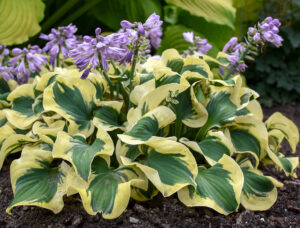
‘Mini Skirt’ is the 2024 Hosta of the Year.
Credit: Walters Gardens Inc.
‘Mini Skirt’
A sport of the miniature ‘Mighty Mouse,’ ‘Mini Skirt’ grows only seven inches tall but displays showy, wavy, thick, blue-green leaves that have wide creamy-yellow margins. Plants produce purple flowers in mid-summer. Best in shade to part shade.
The American Iris Society singles out an unusual or noteworthy iris variety each year as winner of its Iris of the Year honor. The 2024 winner is:
‘Don’t Doubt Dalton’
This tall bearded iris is a heavy bloomer that produces mildly fragrant, long-lasting white flowers that have unusual random reddish-purple speckles. Plants grow three feet tall, ideally in full sun.

‘Tim Herrington’ is winner of the American Daylily Society’s Stout Silver Medal.
Credit: Scott Elliott
Judges from the American Daylily Society bestow a variety of awards on distinctive daylilies, but the top honor is the annual Stout Silver Medal, awarded for the current year each October. The current reigning 2023-24 winner of that award is:
‘Tim Herrington’
The large, three-and-a-half-inch flowers on this hybrid rebloomer are coppery red with yellow midribs. Plants grow about 20 inches, in full sun to light shade.
The American Peony Society each year awards a Gold Medal to a single peony deemed outstanding for its beauty and consistency. New winners are announced in late spring, so the reigning 2023-24 top peony is:
‘Gay Paree’
This heavy-bloomer was hybridized in the 1930s and is a head-turner for its cerise-pink petals that have a tuft of creamy petals on top. Plants are disease-resistant, and flowers are fragrant and good as cut flowers.
Note: Two awards programs were discontinued this year.
One is the Green Ribbon Native Plants program that was run by the staff and Horticulture Committee at Jenkins Arboretum and Gardens in Devon, Pa. Green Ribbon focused on some of our region’s best native plants for home landscapes. The annual awards program is to be replaced later this year by one comprehensive list of plants recommended by their ecological value.
The second discontinued program is the Urban Tree of the Year, an annual selection that was picked by the Society of Municipal Arborists (now the Urban and Community Forestry Society). That program is morphing into an ongoing series of tree profiles in the organization’s City Trees magazine, available as a free read on the UCFS website.







